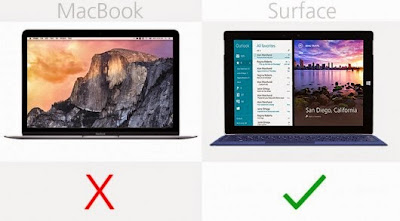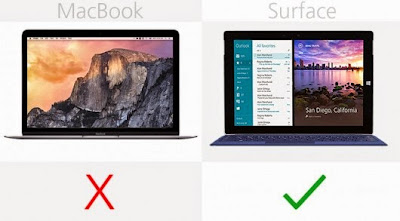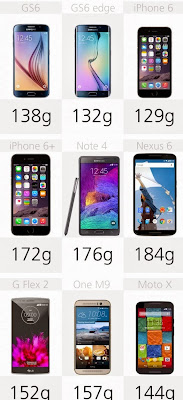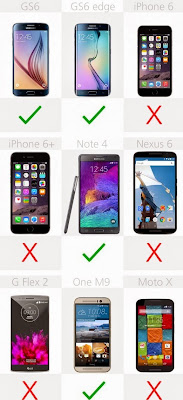2015 Smartphone Comparison Guide
With the first round of 2015 flagship phones hitting store shelves, we thought this would be a good time to revisit our Smartphone Comparison Guide. Join us as we run down the features and specs of some of the top phones you can buy today.
For this early 2015 edition of our Smartphone Comparison Guide, we'll be looking at nine phones – some from this year, and others from late 2014 that are still worth a look:
- Samsung Galaxy S6
- Samsung Galaxy S6 edge
- Apple iPhone 6
- Apple iPhone 6 Plus
- Samsung Galaxy Note 4
- Google/Motorola Nexus 6
- LG G Flex 2
- HTC One M9
- Motorola Moto X (2nd-generation)
Size
All of these phones would look big next to the handsets of three or four years ago, but some are unusually big, even by today's standards (like those phablets in the second row).
If you want an incredibly thin phone, then the Galaxy S6, Galaxy S6 edge, iPhone 6 and iPhone 6 Plus are by far your best bets.
It's worth noting, though, that some of the thicker phones (the Nexus 6, Moto X and HTC One M9) have rounded backs, and the depth numbers you see only count their thickest points. They won't feel quite as beefy in hand as these specs might suggest.
Weight
The Galaxy S6 edge gives you the best size-to-weight ratio, as it's only 2 percent heavier than the iPhone 6, but has a significantly bigger body (and screen).
Build
We have five full premium phones in this bunch: the Galaxy S6, Galaxy S6 edge, iPhone 6, iPhone 6 Plus and One M9. The Galaxy S6 edge is especially sharp-looking, with its glass back, aluminum sides and curved screen that tapers off on either side.
The all-metal HTC One M9 is still one of the best-looking phones you can buy, but its build is growing a bit long in the tooth, after HTC has recycled the same basic design for three straight years. For that reason, we'd place it behind Apple's and Samsung's flagships among the premium phones.
Three more handsets are what we'd call half-premium: the Note 4, Nexus 6 and Moto X. Since the aluminum sides of the phones are typically what you notice the most in your hand, they feel much more premium than their plastic backs would suggest
(though you can also order a Moto X with a higher-end leather or wooden back)
The LG G Flex 2 is the only all-plastic phone in this bunch, with a cheap-feeling aesthetic compared to its eight rivals.
Colors
These are the color options that you can choose from for each phone. The Moto X is the only one you can customize, choosing from 540 total color combinations (once you factor in back, front and trim options) on the Moto Maker website.
Display (size)
If you want a huge screen, then the Nexus 6 is about as good as it gets right now. It also has a great screen-size-to-phone-size ratio. The phone itself is only a little bigger than the iPhone 6 Plus, but the Nexus' display is 18 percent bigger than that of Apple's phablet.
The smallest display, that of the iPhone 6, only gives you 62 percent as much screen as Google's enormous phablet does.
Display (resolution)
Isn't it crazy how quickly new technology can change your perception? Just a year or two ago, 1080p screens seemed like the sharpest anyone would ever need. At the time, we even wondered if they were bordering on pixel overkill.
Well, after Quad HD displays came along, we're now singing a different tune. The ultra-sharp 2,560 x 1,440 screens on the Galaxy S6, Galaxy S6 edge, Nexus 6 and Note 4 give you a degree of eye candy that the other displays can't match. Samsung's new pair of phones are especially striking, squeezing that ultra-high resolution into smaller screens.
This is one of several areas where the HTC One M9 was disappointing. After two years of delivering flagships with top-of-the-line hardware at the time of launch, HTC gave us a display that looks dated compared to its QHD rivals.
Display (type)
Six of the nine phones have AMOLED (or, in the case of the G Flex 2, Plastic-OLED) displays. The other three use IPS panels.
Curved display
We find curved screens to often be little more than gimmicky novelties, but the Galaxy S6 edge's curve, which tapers off on either side of the phone, has one important benefit: it makes the phone look and feel smooth.
The G Flex 2, on the other hand, falls more into the novelty camp. LG would like us all to believe that a phone shaped like a banana is a meaningful innovation – and we admit there is a slight immersive quality to viewing content on a display that hugs around from either end. But for the most part, we don't see the phone's curve as reason enough to buy it.
Stylus
If you think the pen is mightier than the finger, then the Samsung Galaxy Note 4 is still your best bet – with its included S Pen stylus.
The pen in the Note 4 is also more responsive, with more natural-feeling writing, than the pens in the older Galaxy Notes.
Fingerprint sensor
Until the Galaxy S6 and GS6 edge arrived, Apple's Touch ID was the best mobile fingerprint sensor. But the sensors on Samsung's latest are every bit as good – responding by simply touching the home button for a brief moment.
One area where the iPhones' Touch ID still has a leg up is in third-party app integration. While Samsung's sensor is (right now) mostly good for unlocking your phone, Apple's can also be used with a variety of third-party apps – like password managers, Dropbox and Evernote.
There is some app support for the Galaxy sensor, like LastPass and Samsung's own web browser, but that list is pretty short at the moment.
Though the Galaxy Note 4 has a serviceable fingerprint sensor, it's a swipe-based sensor, lagging behind the touch-based sensors on the other four.
Battery
In our video streaming test (over Wi-Fi, with brightness at 75 percent), the Galaxy S6 edge and Galaxy Note 4 had the best results in this group, only dropping 10 percent per hour.
The standard Galaxy S6 was hot on their heels, dropping just 11 percent per hour, while the Nexus 6 and iPhone 6 Plus lost only 12 percent per hour.
Wireless charging
The two Galaxy S6 phones and the Nexus 6 have built-in wireless charging capabilities. The Note 4 can be wireless charging friendly, but you'll need to buy a replacement battery cover to make it work with Qi charging pads.
Fast charging
One of the coolest mobile innovations we've seen in the last year has been quick charging, which can take an almost-dead battery and bring it back to a respectable state quickly (usually from 0 to 50 percent in about 30-40 minutes).
In this group, only the iPhones are missing out on this feature.
Ultra/Extreme Power Saving Mode
Another cool battery feature is a super-duper power saving mode that essentially turns your device into an expensive feature phone (you only have access to a few basic communication-based apps). These modes help you stay on the grid when you're almost out of juice, extending a few percentage points of battery life into hours of uptime.
Camera megapixels (rear)
Photo quality is only partially based on resolution, but these are the pixel counts you'll find in each phone's main camera.
The Galaxy S6 pair, incidentally, has the fastest-loading camera we've seen, capable of going from sleeping phone to snapped picture in as little as two seconds (the next-best are the iPhones, at 3.5 seconds).
Camera megapixels (front)
If you're a selfie-lover, these are the front-facing camera resolutions you'll be working with.
Camera quick launch
Several of these phones have physical shortcuts for launching the camera app. Our favorite is the home button double-tap on the Galaxy S6 and Galaxy S6 edge – which adds to the phones' great camera launch speed. The Moto X's twist gesture is another nifty shortcut.
The G Flex 2's and One M9's shortcuts are less useful, letting you launch their cameras by holding down one of the volume buttons (this ends up taking a while, and ultimately not saving much time).
Camera aperture
The Galaxy S6es have the widest aperture in this group, though the Note 4 and Nexus 6 are close behind.
OIS
All but the iPhone 6, One M9 and Moto X have Optical Image Stabilization for their rear cameras. If you don't exactly have sniper hands, this can help to reduce the effects of camera shake in your pictures.
Storage
These are the storage tiers you'll have to choose from for each phone.
MicroSD
2 and One M9 are the only handsets in this bunch that let you pop in a microSD card to complement their internal storage.
Processor
In our experience, all of these phones are pretty darn fast – with the Galaxy S6 pair probably taking the prize for fastest. The other 2015 releases, the One M9 and G Flex 2, are also doing very well here.
RAM
These are the RAM totals you'll find in each phone. RAM can contribute to overall performance, especially for things like multitasking and switching between browser tabs.
Accidental damage warranty
During the first year of HTC One M9 ownership, the company gives you one do-over. If you break its screen, inflict some water damage or even switch carriers, the "Uh Oh" program lets you get one free replacement. And if you don't use that one replacement during the first year, HTC will give you US$100 off of next year's HTC One.
Software
We're looking at seven Android Lollipop-running handsets along with the two iOS 8-running iPhones.
At the time of writing, though, note that not every carrier has updated its version of the Note 4 to Lollipop.
Release
Four of our phones are from the early 2015 crop, while the rest launched in the last few months of 2014. That means we're probably around five months or so away from the next batch of iPhones and Galaxy Notes.
Starting price (full retail)
High-end smartphones aren't cheap, and if you pay full retail, these are the ballpark figures you'll be working with ("ballpark," because each carrier tends to price things a little differently).
Apart from the iPhones, though, a little hunting may find you lower prices on the aging phones from 2014.
Starting price (on-contract)
This can vary a bit too among carriers and retailers, but these are roughly what you can expect to pay upfront if you're signing a new two-year contract along with your purchase.
Spurred on by T-Mobile, most US carriers now also offer 24-month financing without signing a contract. If your credit is good, that will start at $0 down for most of these handsets.
The best?
So which is the best? Well, that's always a subjective call, but we think the Galaxy S6 and Galaxy S6 edge are really hard to beat right now – with Samsung's first premium designs complementing an awesome all-around user experience and cutting-edge set of specs.
The Nexus 6 has aged well, and is our pick for the best phablet you can buy today. Despite using a late 2014 processor, its UI is just as zippy as the 2015 phones – thanks in no small part to its stock Android software, with no manufacturer skins on top. And of course it also gives you that gorgeous screen that's not just big – it's bordering on tablet size.
The iPhones are still easy to recommend. Despite some specs that look last-gen (or worse) on paper, their user experience is top-notch, with some of the best camera quality and premium design you'll find. And though their screens' pixel counts fall behind the Quad HD phones, Apple balanced that out with outstanding brightness, contrast and color accuracy.
The most disappointing in the bunch are the HTC One M9 and LG G Flex 2. To us, they feel more like early 2014 phones that happen to have 2015 processors, while the Galaxy S6 pair feel like all-new flagships for this year.
























































.jpeg)
.jpeg)
.jpeg)

















.jpeg)
.jpeg)